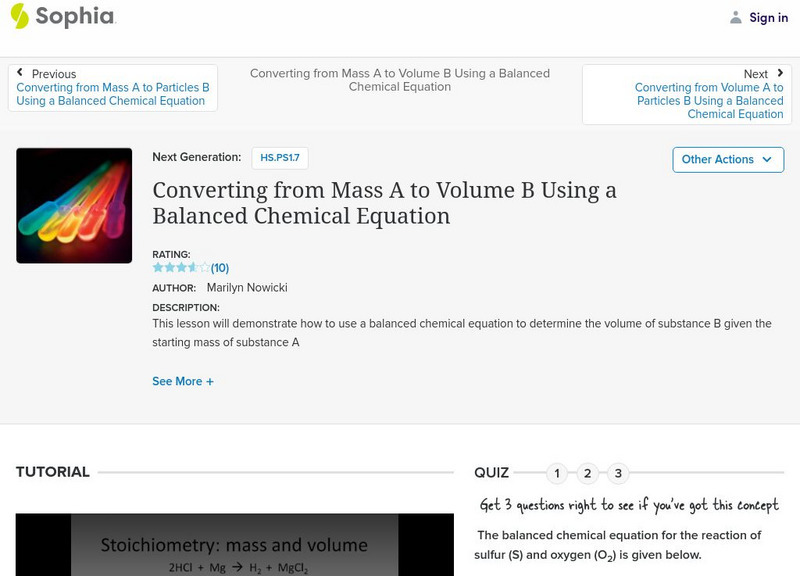Catalyst University
Phase Diagrams | The Clausius-Clapeyron Equation [Derivation Pt. II]
In this video, I use the previously derived Clapeyron equation (previous video [link below]) to derive the Clausius-Clapeyron Equation.
Catalyst University
Physical Chemistry | The Hard Shell Model
1) What is the Hard Shell Model equation of state? 2) What is the constant, b? 3) What does this model tell us about repulsions? 4) Overall, what is the theory of the Hard Shell Model?
Catalyst University
Thermodynamic Parameters for Mixing (ΔG, ΔS, ΔH, ΔV)
Here I explain the basics thermodynamic parameters for mixing two liquids into a mixture.
Catalyst University
Phase Diagrams | The Clausius-Clapeyron Equation [Complete Derivation]
In this video, I show the complete derivation of both the Clausius Equation & the related Clausius-Clapeyron Equation.
Catalyst University
Phase Diagrams | The Clausius-Clapeyron Equation [Derivation Pt. I]
In this video, I show the complete derivation for the Clausius Equation (Part 1). The derivation of the related Clausius-Clapeyron Equation is provided in the link below (Part 2):
Catalyst University
Real Gas Behavior | Determine the Boyle Temperature [Example #1]
In this video, we calculate the Boyle Temperature of a real gas using the compression factor formula.
Catalyst University
General Chemistry | Ideal Gas Law (PV=nRT) [Example #1]
In this video, we will do an example calculation using the ideal gas equation of state, PV=nRT. [Solving for volume, V]
FuseSchool
Calculating Molar Volumes Using Experimental Data
Learn the basics about Calculating molar volumes using experimental data. How do you calculate molar volumes? How do you use experimental data? Find out more in this video!
Catalyst University
Virial Equation of State & The Boyle Temperature
Virial Equation of State & The Boyle Temperature
FuseSchool
How To Calculate Gas Volumes
Do you want to know how to calculate the volume of gases? This chemistry video will show you how to do it with simple real world examples. If you know two of these three, you can work out the third: mass in grams, number of moles and...
FuseSchool
Molar Volume Of Gas
In this video to learn about the molar volumes of gases, how to calculate this and where this knowledge is needed in everyday life.
Catalyst University
Real Gas Behavior | The Compression Factor (Z) [Example #2]
Here, I work a second example in which we calculate a real gas's compression factor.
Catalyst University
Physical Chemistry | The Compression Factor (Z) [w/1 example]
1) What is the compression factor? 2) How is it calculated? 3) What does it tell us about repulsion, attraction, and energy? 4) 1 example of calculating compression factor. ***Another Example: https://youtu.be/Z5NsvRPZT6I
FuseSchool
What Is Avogadro's Number - The Mole
Learn the basics about Avogadro's Number, as a part of chemical calculations. Avogadro’s Number or the Avogadro Constant is 6.02 X 1023 Mol-1. It is the number of atoms per mole of the carbon-12 isotope. For atoms, the mass of Avogadro’s...
FuseSchool
Avogadro's Number - The Mole
Learn the basics about Avogadro's number - The Mole. What is Avogrado's number? Why is it called like that and what relation does it have to the mole? Find more in this video!
JFR Science
Gas Stoichiometry: How Does an Airbag Work?
Airbags save lives ... and combining the Gas Laws and stoichiometry saves time. Find out how airbags inflate using a video from JFR Science. Topics covered include the Ideal Gas Law, standard temperature and pressure, and how to combine...
Teacher's Pet
Stoichiometry
Moles, grams, particles, volume ... how do I keep them all straight? Help pupils sort out the terms and calculations used in stoichiometry with a video tutorial. Topics include mole ratios, molar mass, molar volume, and common...
Fuse School
Calculating Molar Volume Using Experimental Data
Calculating molar volume from experimental data often means the additional challenge of complex numbers and slight errors in measurement. The 23rd video in a 30-part series offers two types of experimental data to work from and models...
Fuse School
Molar Volumes of Gases
In the United States, motor vehicles cause around 75 percent of the carbon monoxide pollution, but how do we measure this pollution? The 21st video in a series of 30 discusses what we mean by molar volumes of gases. It...
Sophia Learning
Sophia: Converting From Moles to Volume
This lesson will provide examples of converting from moles to volume of a gas.
Sophia Learning
Sophia: Converting From Volume to Moles
This lesson will provide examples of converting from volume of a gas to moles of a gas.
Sophia Learning
Sophia: Converting From Grams to Volume
This lesson will provide examples of converting from grams of a gas to volume of a gas.
Sophia Learning
Sophia: Molar Volume of a Gas: Lesson 2
This lesson will define the molar volume of a gas as the volume 1 mole of gas takes up at standard temperature and pressure. It is 2 of 2 in the series titled "Molar Volume of a Gas."
Sophia Learning
Sophia: Converting From Mass a to Volume B Using a Balanced Chemical Equation
This lesson will demonstrate how to use a balanced chemical equation to determine the volume of substance B given the starting mass of substance A.
![Phase Diagrams | The Clausius-Clapeyron Equation [Derivation Pt. II] Instructional Video Phase Diagrams | The Clausius-Clapeyron Equation [Derivation Pt. II] Instructional Video](https://d15y2dacu3jp90.cloudfront.net/images/attachment_defaults/resource/large/missing.png)








